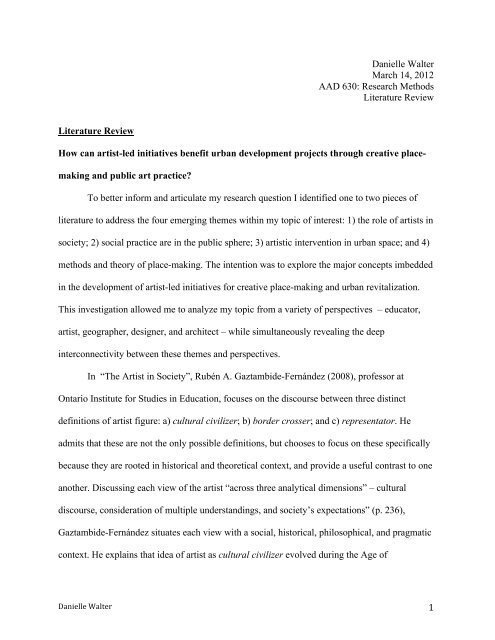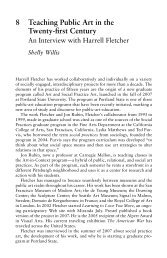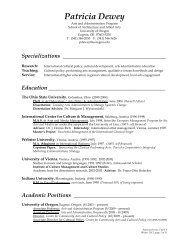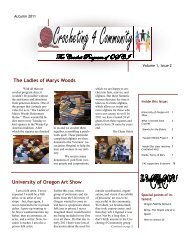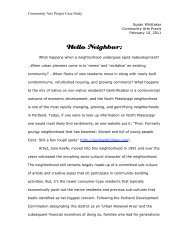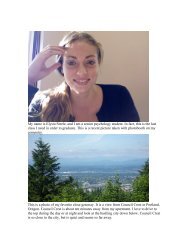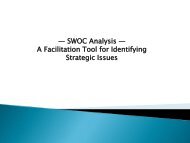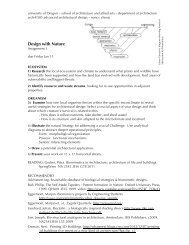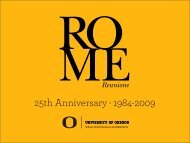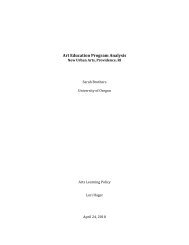Literature Review - School of Architecture and Allied Arts Blog
Literature Review - School of Architecture and Allied Arts Blog
Literature Review - School of Architecture and Allied Arts Blog
Create successful ePaper yourself
Turn your PDF publications into a flip-book with our unique Google optimized e-Paper software.
<strong>Literature</strong> <strong>Review</strong><br />
Danielle Walter<br />
March 14, 2012<br />
AAD 630: Research Methods<br />
<strong>Literature</strong> <strong>Review</strong><br />
How can artist-led initiatives benefit urban development projects through creative place-<br />
making <strong>and</strong> public art practice?<br />
To better inform <strong>and</strong> articulate my research question I identified one to two pieces <strong>of</strong><br />
literature to address the four emerging themes within my topic <strong>of</strong> interest: 1) the role <strong>of</strong> artists in<br />
society; 2) social practice are in the public sphere; 3) artistic intervention in urban space; <strong>and</strong> 4)<br />
methods <strong>and</strong> theory <strong>of</strong> place-making. The intention was to explore the major concepts imbedded<br />
in the development <strong>of</strong> artist-led initiatives for creative place-making <strong>and</strong> urban revitalization.<br />
This investigation allowed me to analyze my topic from a variety <strong>of</strong> perspectives – educator,<br />
artist, geographer, designer, <strong>and</strong> architect – while simultaneously revealing the deep<br />
interconnectivity between these themes <strong>and</strong> perspectives.<br />
In “The Artist in Society”, Rubén A. Gaztambide-Fernández (2008), pr<strong>of</strong>essor at<br />
Ontario Institute for Studies in Education, focuses on the discourse between three distinct<br />
definitions <strong>of</strong> artist figure: a) cultural civilizer; b) border crosser; <strong>and</strong> c) representator. He<br />
admits that these are not the only possible definitions, but chooses to focus on these specifically<br />
because they are rooted in historical <strong>and</strong> theoretical context, <strong>and</strong> provide a useful contrast to one<br />
another. Discussing each view <strong>of</strong> the artist “across three analytical dimensions” – cultural<br />
discourse, consideration <strong>of</strong> multiple underst<strong>and</strong>ings, <strong>and</strong> society’s expectations” (p. 236),<br />
Gaztambide-Fernández situates each view with a social, historical, philosophical, <strong>and</strong> pragmatic<br />
context. He explains that idea <strong>of</strong> artist as cultural civilizer evolved during the Age <strong>of</strong><br />
Danielle Walter 1
Enlightenment <strong>and</strong> was a product <strong>of</strong> liberal humanist theory. In the role <strong>of</strong> cultural civilizer, the<br />
artist’s talent, personality, <strong>and</strong> contribution to the world is considered far superior to that <strong>of</strong><br />
others, <strong>and</strong> society equates artist with genius.<br />
The concept <strong>of</strong> artist as border crosser, in contrast, draws on postmodern, feminist, <strong>and</strong><br />
postcolonial cultural philosophy, <strong>and</strong> is rooted in critical theory. As border crosser, the artist is<br />
“not understood as a subject with special abilities for creating works <strong>of</strong> art that are valuable for<br />
their own sake, but is imagined as someone who has a critical view <strong>of</strong> social structures <strong>and</strong> can<br />
discern how to mobilize symbols to challenge boundaries” (p. 245). In this way, artists are<br />
expected to transcend cultural conventions, incite innovative thought <strong>and</strong> contribute an<br />
ethnographic perspective to the course <strong>of</strong> society.<br />
Gaztambide-Fernández grounds the third notion <strong>of</strong> the artist, as representator, in the<br />
cultural populism theory <strong>of</strong> Rhys H. Williams. Cultural populism is a democratic approach to<br />
cultural issues <strong>of</strong> representation, meaning-making <strong>and</strong> public life, in which the artist plays a<br />
crucial role by reflecting <strong>and</strong> representing the concerns <strong>and</strong> mind-set <strong>of</strong> his or her society <strong>and</strong> is<br />
not considered a higher source <strong>of</strong> intelligence located outside the public sphere. Artists, as<br />
representators, “are part <strong>of</strong> a large web <strong>of</strong> meaning in which they are just the most obvious but<br />
least important actors” (p. 249). Rather claiming the validity <strong>of</strong> one definition over the other,<br />
Gaztambide-Fernández urges academic <strong>and</strong> cultural institutions to examine the “various<br />
overlaps between the three different view <strong>of</strong> the artist <strong>and</strong> her/his role in society” (p. 257).<br />
Artists <strong>of</strong> the 21 st century are “at a crossroads <strong>of</strong> discursive <strong>and</strong> disciplinary implosion” (p. 258).<br />
In order to play an active <strong>and</strong> relevant role in cultural identity construction, artist must be<br />
allowed “a public space where they can engage with the audience in a collective process <strong>of</strong> re-<br />
presentation outside the purview <strong>of</strong> the culture industry” (p. 257). Cultural practitioners should<br />
Danielle Walter 2
not rely on one narrow definition <strong>of</strong> artist, but rather encourage <strong>and</strong> foster open <strong>and</strong> ongoing<br />
dialogue between all three roles.<br />
Social practice art is becoming an increasingly recognized field within the academic,<br />
pr<strong>of</strong>essional, <strong>and</strong> public sectors. Suzanne Lacy – artist, activist, <strong>and</strong> writer – is a widely<br />
recognized scholar <strong>of</strong> evolving public art practice. She is well known for her book, “Mapping<br />
the Terrain: New Genre Public Art” (1995), that illustrates the emerging trend <strong>of</strong> politically <strong>and</strong><br />
civically activated art projects, which she calls new genre public art, through a variety <strong>of</strong> case<br />
studies. In 2008, Lacy reflected back on the field’s progression in “Time in Place: New Genre<br />
Public Art a Decade Later”. She explains that toward the end <strong>of</strong> the 20 th century federal funding<br />
for modernist art projects <strong>and</strong> programming significantly decreased due to a series <strong>of</strong> public art<br />
controversies. Any artist that did appear as, what Gaztambide-Fernández would refer to as, a<br />
cultural civilizer struggled to find funding. Lacy cites the Ford Foundation’s investment in civic<br />
arts, including the Animating Democracy Initiative, the Institute on the Art <strong>and</strong> Civic Dialogue,<br />
<strong>and</strong> the American Festival Project, as evidence <strong>of</strong> a major shift in national attention towards<br />
new genre public art a decade later.<br />
Lacy addresses the challenge <strong>of</strong> developing critical methods <strong>of</strong> evaluation for new genre<br />
art projects, including process <strong>and</strong> outcome based objectives. “It is important to locate these art<br />
practices within the trajectories <strong>of</strong> art history <strong>and</strong> cultural theory to give real texture <strong>and</strong><br />
meaning to the notion <strong>of</strong> artist citizenship, <strong>and</strong> in so doing reconstruct the civic relevance <strong>of</strong> art”<br />
(p. 31). She recommends three strategies: “the ‘close reading’ <strong>of</strong> specific projects embedded in<br />
their locality; ‘mulitvocal’ criticism that compiles diverse viewpoints; <strong>and</strong> alignment with<br />
economic, aesthetic, <strong>and</strong> cultural theories that draw on the ‘continental theory canon’, but do not<br />
necessarily give it priority over other histories or theories” (pp. 21-22). In other words, it is<br />
Danielle Walter 3
necessary to conduct comprehensive case documentation <strong>and</strong> analysis, solicit critical discourse<br />
equally, <strong>and</strong> examine issues through the lens <strong>of</strong> multiple philosophical, political, <strong>and</strong> academic<br />
perspectives. I foresee this set <strong>of</strong> guidelines informing my own underst<strong>and</strong>ing <strong>and</strong> analysis <strong>of</strong><br />
the case studies in my research.<br />
After an investigation <strong>of</strong> the philosophical role <strong>of</strong> the artist <strong>and</strong> a present-day look at the<br />
public policy <strong>of</strong> new genre art, I turned my attention to methods <strong>of</strong> creative civic engagement in<br />
an urban setting. I explored the observations <strong>and</strong> findings <strong>of</strong> David Pinder, Pr<strong>of</strong>essor <strong>of</strong><br />
Geography at the University <strong>of</strong> London, in his article “<strong>Arts</strong> <strong>of</strong> urban exploration” (2005). Pinder<br />
bases his discussion on the art interventions <strong>of</strong> Brooklyn-based artist groups that seek to<br />
instigate playful <strong>and</strong> provocative art interventions on the streets <strong>of</strong> New York. Pinder wants to<br />
uncover how artists can enact civic change <strong>and</strong> defend public space. He cites his first-h<strong>and</strong><br />
observations; he draws on the theories <strong>of</strong> established philosophers <strong>and</strong> scholars; <strong>and</strong> includes<br />
anecdotal feedback from artists <strong>and</strong> media sources. Situationist theory <strong>and</strong> psychogeography are<br />
the foundation <strong>of</strong> his critical study <strong>of</strong> the perceived notions <strong>of</strong> urban spaces <strong>and</strong> their implied<br />
values.<br />
Pinder challenges the common assumption that artists serve merely to beautify <strong>and</strong><br />
inspire urban renewal projects. “It is not simply an issue <strong>of</strong> asking what artists can do in a<br />
narrow instrumental sense to bring about progressive urban change, but rather <strong>of</strong> opening up<br />
through such practices the potential for collaboration, interventions, re-imaginings that disrupt<br />
<strong>and</strong> exp<strong>and</strong> senses <strong>of</strong> both the city <strong>and</strong> self" (p. 404). Pinder draws connections between<br />
psychogeography <strong>and</strong> urban exploration techniques. Walking, for example, is powerful mode <strong>of</strong><br />
access, discovery, <strong>and</strong> action. Intentional, accidental, <strong>and</strong> subversive pedestrian path-making<br />
contributes to the identity <strong>and</strong> vitality urban communities. Mapping exercises <strong>and</strong> storytelling<br />
Danielle Walter 4
are creative approaches to uncovering the hidden values <strong>and</strong> assumption <strong>of</strong> a city. “To<br />
intervene through creative practice in public space today in New York <strong>and</strong> other cities is to enter<br />
into a crucial struggle over the meaning, values <strong>and</strong> potentialities <strong>of</strong> that space at a time when<br />
democracy is highly contested ” (p. 398). The complexity <strong>of</strong> perspectives within the urban<br />
environment makes it impossible for one’s knowledge <strong>of</strong> a city to ever be complete, but<br />
experimentation <strong>and</strong> exploration will always be vital to revitalization <strong>and</strong> enrichment.<br />
Pinder is primarily concerned with uplifting <strong>and</strong> preserving the ‘rights to the city’ <strong>and</strong><br />
methods <strong>of</strong> ‘writing the city’ as a means <strong>of</strong> strengthening each citizen’s connection to <strong>and</strong><br />
respect for place (p. 387). In their book, “Place-making: The Art <strong>and</strong> Practice <strong>of</strong> Building<br />
Communities”, Lynda H. Schneekloth <strong>and</strong> Robert G. Shibley argue that the pr<strong>of</strong>essional<br />
appropriation <strong>of</strong> place-making – embodied in the fields <strong>of</strong> architecture, urban planning, civic<br />
engineering, <strong>and</strong> l<strong>and</strong>scape design - has traditionally denied the rest <strong>of</strong> the community<br />
participation in a fundamental mode <strong>of</strong> human expression. If, however, pr<strong>of</strong>essional place-<br />
makers can recognize the scope <strong>and</strong> implications <strong>of</strong> their actions, they have great potential to<br />
affect positive change. The term “intervention”, though varying slightly in definition, can be<br />
found throughout each piece <strong>of</strong> literature I reviewed <strong>and</strong> is emerging as a valuable concept in<br />
my research. Schneekloth <strong>and</strong> Shibley claim, “All pr<strong>of</strong>essional place-making activities are<br />
interventions” (p. 13). It is vital to approach interventions in both physical <strong>and</strong> imagined space,<br />
with intention <strong>and</strong> caution.<br />
Schneekloth <strong>and</strong> Shibley attempt to outline a best practice approach to place-making for<br />
artists, design pr<strong>of</strong>essional, <strong>and</strong> community leaders, alike. Place-makers must undertake the<br />
following tasks: a) make ‘dialogic space’ by facilitating respectful <strong>and</strong> open discussion; b)<br />
conduct exercises <strong>of</strong> ‘confirmation’ (affirming aspects that are working) <strong>and</strong> ‘interrogation’<br />
Danielle Walter 5
(critically analyzing conventions <strong>and</strong> challenges); <strong>and</strong> c) employ ‘framing action’ by allowing<br />
these insights to guide <strong>and</strong> inform subsequent actions. This recommendation is “based on a<br />
worldview that assigns legitimacy to every person’s experience <strong>of</strong> living, to the potential<br />
competence <strong>and</strong> compassion <strong>of</strong> human action, <strong>and</strong> to the fundamental importance <strong>of</strong> place as an<br />
actor in living well” (p. 8) The social activism tactic <strong>and</strong> educational theory <strong>of</strong> Paulo Friere is at<br />
the core <strong>of</strong> Schneekloth <strong>and</strong> Shibley’s approach to place-making, drawing on non-elitist forms<br />
<strong>of</strong> leadership <strong>and</strong> encouraging critical questioning <strong>of</strong> one’s surroundings in order to deconstruct<br />
the forces at work. They assert that the production <strong>of</strong> knowledge is rooted in practice.<br />
“To rehabilitate only the physical structure does not does not create the conditions for<br />
change” (p. 16). Despite societal pressures to adhere to institutional boundaries <strong>and</strong> minimal<br />
expectations, place-makers should encourage a free flowing exchange <strong>of</strong> responsibility <strong>and</strong><br />
vision. Artists, with the ability to reflect <strong>and</strong> engage their community, have great potential to<br />
take on this task <strong>and</strong> exp<strong>and</strong> the social implications <strong>of</strong> urban design. Schneekloth <strong>and</strong> Shibley,<br />
however, warn <strong>of</strong> certain risks involved when bringing issues <strong>of</strong> place in to public discourse.<br />
The act <strong>of</strong> communal place-making requires a high level <strong>of</strong> trust, open collaboration, <strong>and</strong><br />
accountability. Grounded in community cultural development theory, it is suggested that<br />
without true caring <strong>and</strong> respect, exercises in collaboration will be an artificial <strong>and</strong> meaningless.<br />
Lastly, I examined “Identity by Design”, a guide to urban design practice focused on the<br />
mediation between physical <strong>and</strong> imagined community identity written by two pr<strong>of</strong>essors at<br />
Oxford Brookes University, Georgia Butina Watson <strong>and</strong> Ian Bentley. Between the two <strong>of</strong> them,<br />
they are well versed in architecture, city planning, urban regeneration, urban morphology,<br />
cultural studies, <strong>and</strong> public art. Published over ten years after “Placemaking”, “Identity by<br />
Design” makes the assertion that pr<strong>of</strong>essional urban designers are agents <strong>of</strong> civic <strong>and</strong> cultural<br />
Danielle Walter 6
transformation. The methodological approach <strong>and</strong> case studies outlined by Watson <strong>and</strong> Bentley<br />
illustrate a progression in the pr<strong>of</strong>essional <strong>and</strong> academic underst<strong>and</strong>ing <strong>of</strong> <strong>and</strong> appreciation for<br />
cultural place-making in the last decade. The designer possesses a thorough knowledge <strong>of</strong> the<br />
morphological elements, including topography, hydrology, linkage networks, block, l<strong>and</strong> plots<br />
<strong>and</strong> building structures, <strong>and</strong> therefore it is their duty to “organize these elements <strong>and</strong> the<br />
relationships <strong>and</strong> interfaces between them, so as to foster positive support for our place-identity<br />
agenda: maximizing choice, constructing rootedness <strong>of</strong> imagined community, overcoming<br />
nostalgia, supporting a sense <strong>of</strong> transcultural inclusiveness <strong>and</strong> co-dwelling with the wider<br />
ecosphere, for as many users as possible” (p. 262).<br />
Watson <strong>and</strong> Bentley advocate for a new definition <strong>of</strong> Modernism as it pertains to the<br />
design sector. “Modern design” has become too preoccupied with aesthetic <strong>and</strong> the latest<br />
technological advancements. To be truly modern, designers must “use the best knowledge we<br />
have to face up to current design challenges – today certainly including problems <strong>of</strong> place-<br />
identity – <strong>and</strong> have the courage to move in whichever direction that may lead” (p. 270).<br />
Culturally <strong>and</strong> socially relevant urban design focuses on the link between place <strong>and</strong> identity.<br />
Watson <strong>and</strong> Bentley define place-identify as “the set <strong>of</strong> meanings associated with any particular<br />
cultural l<strong>and</strong>scape which any particular person or group <strong>of</strong> people draws on in the constructions<br />
<strong>of</strong> their own personal or social identities” (p. 6). Individualistic approach to urban design <strong>and</strong> art<br />
making, motivated by superficial or detached factors, prevents constructive collaboration<br />
between artists/designers <strong>and</strong> their community. “If issues <strong>of</strong> place-identity are indeed central to<br />
our time, then it is crucial for art to reconnect with them” (p.271). By confronting <strong>and</strong><br />
challenging society’s perception <strong>of</strong> artists, conducting ‘close readings’ <strong>of</strong> progressive art<br />
interventions in civic spaces, <strong>and</strong> reexamining the relationship between pr<strong>of</strong>essional urban<br />
Danielle Walter 7
designers <strong>and</strong> their communities, cultural workers can continue to exp<strong>and</strong> the place-based<br />
possibilities <strong>of</strong> art-based civic engagement.<br />
Danielle Walter 8
Reference List<br />
Gaztambide-Fernández, R.A. (2008). The artist in society: underst<strong>and</strong>ings, expectations, <strong>and</strong><br />
curriculum implications. Curriculum Inquiry, 38(3), 233-265. doi:10.1111/j.1467-<br />
873X.2008.00408.x<br />
Lacy, S. (1995). Mapping the terrain: new genre public art. Seattle, WA: Bay Press.<br />
Lacy, S. (2008). Time in place: new genre public art a decade later. In Cartiere, C. & Willis, S.<br />
(Eds.), The practice <strong>of</strong> public art (pp. 18-32). New York, NY: Routledge.<br />
Pinder, D. (2005). <strong>Arts</strong> <strong>of</strong> urban exploration. Cultural Geographies, 12, 383-411.<br />
Schneekloth, L.H. & Shibley, R.G. (1995). Placemaking: the art <strong>and</strong> practice <strong>of</strong> building<br />
communities. New York, NY: John Wiley & Sons, Inc.<br />
Watson, G.B. & Bentley, I. (2007). Identity by design. Oxford, UK: Elsevier.<br />
Danielle Walter 9


